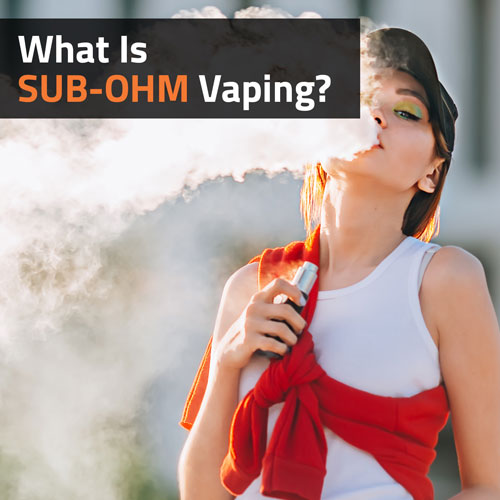Sub-ohm vaping is a well-loved vaping style amongst vape enthusiasts. This method produces big clouds of vapour and an intense burst of flavour profiles. Some devices, mods, and e-liquids are specifically made for sub-ohm vaping, ensuring the best and safest vaping experience tailored to your vaping method. To get the most out of your sub-ohm vaping experience, you will need to know which devices, components, and juices will best suit your style.
Sub-Ohm Vaping
Sub-ohm refers to vaping with a device that has a coil resistance below 1 Ω. Most regular vaporizers have a coil resistance between 1.5 Ω and 3 Ω (also known as above-ohm coils).
Sub-ohm devices have a lower resistance, which causes the atomizer to heat up faster and more liquid to be vaporized. This produces a more robust flavour profile of your e-liquid and denser clouds as the current passing through the coil is enhanced.
Pros And Cons Of Sub-Ohm Vaping
Like all vaping methods, sub-ohm vaping has its pros and cons. Whether sub-ohm vaping will suit you or not depends on what you want to get out of your vaping experience.
Pros Of Sub-Ohm Vaping
- Produces big, dense clouds of vapour that are perfect for vaping tricks.
- Increases the overall flavour of your e-liquid, as you are inhaling much more vapour than an above-ohm device can provide.
- A stronger hit is provided as you are inhaling more of your vaping substance. This is one of the reasons why sub-ohm vaping is recommended for experienced vapers.
Cons Of Sub-Ohm Vaping
- Sub-ohm devices are more expensive when compared to above-ohm devices.
- Coils burn out faster due to the intensity of vapour production, so you will have to replace these more often.
- You will have to refill your tank much more often than with above-ohm devices, as you will be vaping much more of your substances.
Factors That Affect Your Sub-Ohm Vaping Experience
If you are looking to take up sub-ohm vaping, you should consider three main factors: coil resistance, wattage, and battery voltage. All of these factors will impact your sub-ohm vaping experience.
Coil Resistance
Coil resistance is the deciding factor for sub-ohm vaping, as you cannot vape sub-ohm unless your coil has a resistance below 1 Ω – usually between 0.2 Ω and 0.8 Ω. Additionally, coils that have an increased surface area will conduct a larger current due to the lowered resistance. Thinner coils will have the opposite effect, as wattage output and resistance are inversely proportional – as one increases, the other naturally decreases. Therefore, thinner coils have a lower wattage output, which results in a higher coil resistance (which is the opposite of what you want for sub-ohming).
Wattage
Wattage refers to the actual power generated by your device’s electrical unit. A higher wattage will produce more heat, resulting in increased vapour production and a more intense flavour profile. Devices with a minimum output of 40 Watts are suitable for sub-ohming, but wattage levels can go up to and over 200 Watts, so you have a wide scope to choose from. Most sub-ohmers enjoy an output between 40 Watts and 70 Watts.
Battery Voltage
Battery voltage refers to the power generated by your device’s battery. An increased battery voltage means that you will have higher wattage, provided that your coil resistance is low as well. A popular battery power option among sub-ohmers lies between 28 Watts and 35 Watts.
The Perfect Combination For Sub-Ohming
Based on the factors that influence your sub-ohm vaping experience, your ideal device should have a coil resistance below 1 Ω, a high wattage (anything above 40 Watts), and a battery with a high voltage (between 28 and 35 Watts). This will allow your device to produce strong hits and big clouds with maximum output. You will also be able to experience the best flavour profile of your e-liquids.
All of these factors influence each other greatly, so it is important to make sure that you stay within the recommended ranges for the best sub-ohming experience. If one of these elements is off, your hits will be average, your device will produce smaller clouds, and you will not be able to experience the full effect of sub-ohm vaping.
Suitable Vaping Devices For Sub-Ohm Vaping
Since sub-ohm vaping requires a coil resistance below 1 Ω, not all vaping devices are suitable for sub-ohming. Some tanks that accommodate sub-ohming include:
- Sub-Ohm Tanks
- Rebuildable Tank Atomizers (RTAs)
- Rebuildable Dripping Atomizers (RDAs)
Sub-Ohm Tanks
Sub-ohm tanks are usually made from stainless steel and glass. Their coils are intentionally made with a sub-ohm resistance, are produced commercially, and are disposable. These tanks are specifically made for vapers who cannot or prefer not to build their own coils, but still want to experience sub-ohm vaping. Suitable tanks include:
- Geekvape Z Sub-Ohm Tank 5ml
- Hellvape Fat Rabbit Subohm Tank
- Vaporesso ITank Sub-Ohm 8ml
- Hellvape Fat Rabbit Subohm Tank
Rebuildable Tank Atomizers (RTAs)
RTAs are vaping tanks with rebuildable decks. Users will have to build their own coils to place within the tank. Since e-liquid is stored in the tank, there is no need for dripping. RTA tanks include:
- Hellvape Dead Rabbit 3 RTA
- OXVA Arbiter 2 RTA Tank
- VandyVape Kylin Mini V2 RTA
- Geekvape Zeus X II Mesh RTA 4.5ml
Rebuildable Dripping Atomizers (RDAs)
RDAs consist of a customized coil and cotton, which you will have to wrap around your coil. These devices do not contain a tank, so e-liquid should be dripped into the wick until it is fully saturated and properly primed. RDA tanks include:
Suitable E-Liquids For Sub-Ohm Vaping
Freebase liquids consist of Propylene Glycol (PG), Vegetable Glycerin (VG), or a combination of both. The PG/VG concentration of your e-liquid should be taken into account when sub-ohming.
PG has a thinner consistency, producing a stronger throat hit and good flavour production. VG is a more viscous liquid that produces a milder throat hit and thicker, denser clouds. For sub-ohm vaping, the ideal e-liquid should have a higher VG concentration, since liquids with a higher PG level will be very harsh on the throat.
Suitable Nicotine Levels For Sub-Ohming
Since sub-ohming means that you will be inhaling more of your vaping substance, the process will also increase the level of nicotine you will consume. As the vaporisation process is so intense, the ideal e-liquid for sub-ohming will have a low nicotine content.
A nicotine concentration of 12 mg/ml or lower is considered safe for sub-ohming. Choosing e-liquids with the right PG/VG ratio and nicotine concentration will enhance your sub-ohm vaping experience, since it will make the vapour smooth and thick without being too harsh on your throat and lungs.
Do Not Use Nic Salts In Sub-Ohm Devices
Nic Salts are e-liquids that have very high nicotine levels. Using Nic Salts in a sub-ohm device will not only make your experience much less enjoyable, it can also be hazardous to your health. You may even experience mild nicotine poisoning – symptoms include:
- Nausea and vomiting
- Increased salivation
- Abdominal pain
- Sweating
- Rapid or heavy breathing
- Headaches and dizziness
- Increased heart rate and blood pressure
These symptoms can appear within 15 minutes of sub-ohming Nic Salts and usually last up to an hour before decreasing in severity. Less severe symptoms may stick around for several hours. If you use the right devices and e-liquids, you do not need to worry about nicotine poisoning, so do not use Nic Salts with sub-ohm devices.
Sub-ohm vaping has become quite popular due to its rich flavour production, strong hits, and its capability to create big and dense clouds. Although sub-ohming may be somewhat more expensive than regular vaping, it is worth it if this vaping style suits your needs. Make sure that you use the right devices, coils, and e-liquids for a safe and enjoyable sub-ohming experience, and take the time to understand the process of sub-ohming and the suitable products before you start experimenting.






